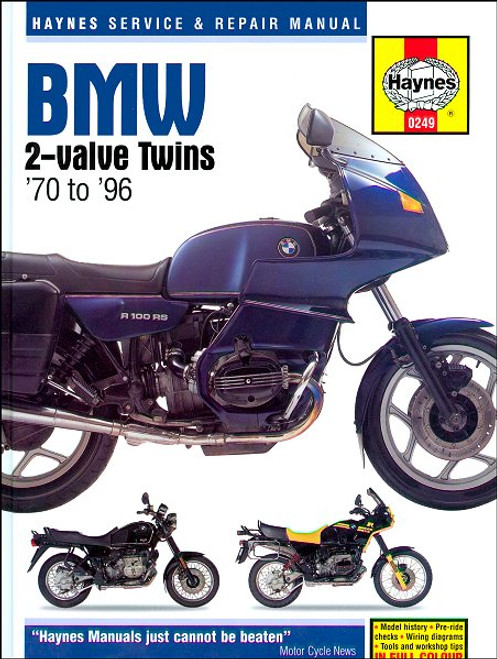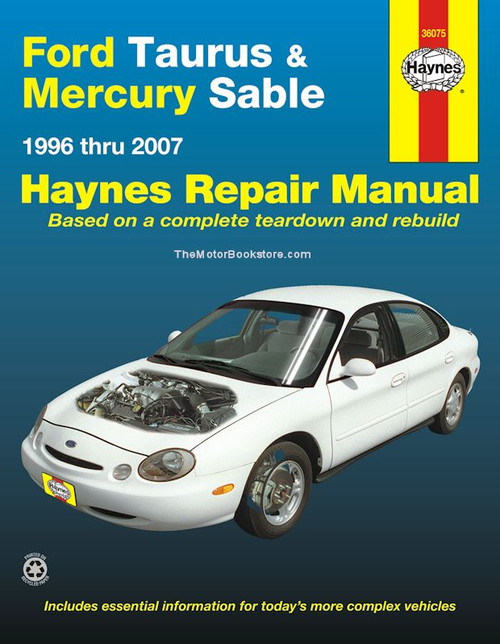Looking to restore or maintain your BMW motorcycle? This manual covers some of the most classic BMW 2-Valve Twins models, including 1970-1996 R45, R50, R60, R65, R75, R80, R90, R100, etc. These are motorcycles that have stood the test of time for a reason. These powerful machines were built with a precision and quality found only in BMW cycles. And with this repair manual by Haynes, it's easy to stay on top of maintenance for your motorcycle at home.
Many pros might have you think that only a certified mechanic is qualified to work on your 1970-1996 BMW motorcycle, but the truth is that much of the work can be done with a DIY attitude and a little research. This guide provides all the info you need for working on everything from the brakes and suspension to the tires and instrumentation. The following models are covered in this manual:
- BMW R45 UK only 1978-1985
- BMW R50 UK 1970-1973, US 1969-1973
- BMW R60 UK 1970-1978, US 1969-1978
- BMW R65 and R65LS UK 1978-1988, US 1979-1987
- BMW R75 UK 1970-1977, US 1969-1977
- BMW R80, R80/7, R80G, R80S*, R80GS, R80ST, R80RT, R80R UK 1977-1994, US 1977-1987
- BMW R90/6, R90S UK and US 1973-1976
- BMW R100, R100/7, R100CS, R100GS*, R100R, R100RS, R100RT, R100S, R100SP, R100SRS, R100ST, R100T, R100TR UK and US 1976-1984, 1987-1996
* Includes coverage of the Paris-Dakar versions.
Notice: The 4-valve engine introduced in 1993 is NOT covered by this manual.
Engine: Air-cooled, horizontally-opposed transverse twin, with pushrod operated overhead valves, ranging from 473cc to 979cc.
Book Excerpt: 1970-1996 BMW 2-Valve Twins Repair Manual FRAME AND FRONT SUSPENSION
GENERAL DESCRIPTION The front forks are of the conventional coil-sprung hydraulically damped type with a characteristically (for BMW) long travel. Seven types of fork are fitted to the machines described in this manual.
- /5,/6 and /7 models up to 1980 all share the same type.
- R45 and R65 up to 1985 models, when introduced, were fitted with a new type developed by Fichtel and Sachs which are simpler in design but have a shorter travel; these forks are also used on the R65LS.
- All /7 models from 1981 on, the R80G/S and the R80RT 1983-1984 use a modified version of the Fichtel and Sachs forks which retain the long travel of the original design but have better damping and, due to the use of some Teflon components, are quieter in operation.
- Although not a separate type in its own right, the R80ST uses forks which combine the stanchion and damping mechanism layout of the later /7 models with the lower leg and spring of the R45/65 forks; the effect of this is to convert the R80G/S cycle parts into a good-handling road-going version.
- The R65 from 1986, R80 and R80RT from 1985, R100RS and R100RT from 1987 use a slightly modified form of the fork type developed for the K100 series models.
WHEELS, BRAKES AND TIRES
GENERAL DESCRIPTION The types of wheel and brake fitted to each model are given in the Specification Section of this Chapter. Wire-spoked wheels consist of a light alloy rim joined to a full-width light alloy hub by a number of steel spokes. Note that on /5 models (frame numbers (R50/5) 2903 756, (R60/5) 2939 207, (R75/5) 2983 280, and later) the rear rim width was increased. If the rear rim of an earlier model is to be renewed at any time, it should be replaced by the wider rim to improve the machine's stability. On R80G/S, R80ST, R80GS, R80R, R100GS and R100R models, if the rear wheel requires re-spoking or a new rim, it should be taken to a BMW dealer. The rim offset from the hub varies according to the year of production and must be checked only by an expert or there is a risk of the tire rubbing on the frame. FRONT WHEEL: REMOVAL AND REFITTING ALL MODELS: GENERAL
- Place the machine on its centerstand and wedge a wooden block or similar under the sump so that the front wheel is clear of the ground. On machines fitted with twin disc brakes mark the hub so that it is refitted the original way round (see illustration); this avoids having to reset the calipers (early models) and prevents premature pad wear (later models).
- During wheel removal make a careful note of any washers and spacers fitted: these must be refitted in their original locations. Also wedge a piece of wood between the brake pads; do not apply the brake lever.
- When the wheel has been refitted, tighten the spindle nut (or Allen screw) to its specified torque setting, then push the machine off its stand and apply the front brake (having refitted the calipers, where applicable). Pump the forks up and down several times to align the fork lower legs on the spindle, then raise the machine on to its centerstand and tighten the spindle clamps to their specified torque settings. On all models with disc brakes apply the lever repeatedly to bring the pads back into contact with the disc(s).
Subject: 1970, 1971, 1972, 1973, 1974, 1975, 1976, 1977, 1978, 1979, 1980, 1981, 1982, 1983, 1984, 1985, 1986, 1987, 1988, 1989, 1990, 1991, 1992, 1993, 1994, 1995, 1996 BMW R45, R50, R60, R65, R75, R80, R90, R100 service, maintenance, repair. ISBN-10: 3834500249 | ISBN-13: 9780857339027 | Haynes 0249
- Identification numbers
- Buying spare parts
- Pre-ride checks
- Engine oil level
- Brake fluid levels
- Tires
- Bike specs
- Routine maintenance and servicing
- Specifications
- Lubricants and fluids
- Maintenance schedule
- Component locations
- Maintenance procedures
- Engine, clutch and transmission
- Fuel and exhaust systems
- Ignition system
- Frame and suspension
- Brakes, wheels and final drive
- Fairing and bodywork
- Electrical system
- Wiring diagrams
- Tools and workshop tips
- Security
- Storage
- Troubleshooting











Above: Nelson Emmons sent this photo of his 1971 BMW R75/5. The bike is a "barn find" European-delivery R75/5 with less than 5000 km. Nelson purchased the bike in Frankfurt Germany, as a future restoration project. Essex, MA.